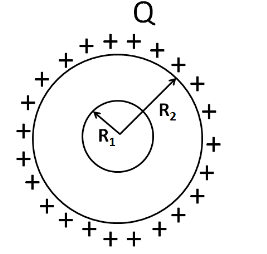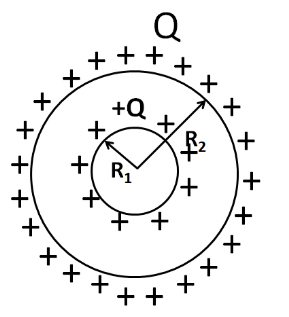
The capacitance of two concentric spherical shells of radii $ {R_1} $ and $ {R_2} $ $ \left( {{R_2} > {R_1}} \right) $ is:
(A) $ 4\pi {\varepsilon _0}{R_2} $
(B) $ 4\pi {\varepsilon _0}\dfrac{{{R_2} - {R_1}}}{{{R_1}{R_2}}} $
(C) $ 4\pi {\varepsilon _0}\dfrac{{{R_1}{R_2}}}{{{R_2} - {R_1}}} $
(D) $ 4\pi {\varepsilon _0}{R_1} $
Answer
554.4k+ views
Hint: To solve this question, we need to consider a charge on the system of spherical shells. Then we have to find out the potential difference in the system with the help of the charge distribution in the system. Finally, we have to apply the basic formula of the capacitance to get the final answer.
Formula used: The formulae which are used to solve this question are given by
$\Rightarrow V = \dfrac{Q}{{4\pi {\varepsilon _0}R}} $, here $ V $ is the potential on a sphere of radius $ R $ which has a charge of $ Q $.
$\Rightarrow C = \dfrac{Q}{V} $, here $ C $ is the capacitance, $ Q $ is the charge, and $ V $ is the potential difference.
Complete step by step answer
Let us consider the two spherical shells of radii $ {R_1} $ and $ {R_2} $ as shown in the figure below. Let the outer sphere be charged with a charge of $ + Q $. The charge will get distributed on the whole surface of the outer spherical shell.

Due to the positive charge on the outer sphere, an equal amount of positive charge will appear at the outer surface of the inner sphere, as shown in the figure below.

So the potential of the outer spherical shell becomes
$\Rightarrow {V_1} = \dfrac{Q}{{4\pi {\varepsilon _0}{R_2}}} $ ………………….(1)
Also the potential of the inner spherical shell is
$\Rightarrow {V_2} = \dfrac{Q}{{4\pi {\varepsilon _0}{R_1}}} $ ………………………….(2)
So the net potential difference between the two spherical shells is
$\Rightarrow V = {V_2} - {V_1} $
From (1) and (2)
$\Rightarrow V = \dfrac{Q}{{4\pi {\varepsilon _0}{R_1}}} - \dfrac{Q}{{4\pi {\varepsilon _0}{R_2}}} $
$ \Rightarrow V = \dfrac{Q}{{4\pi {\varepsilon _0}}}\left( {\dfrac{1}{{{R_1}}} - \dfrac{1}{{{R_2}}}} \right) $
On simplifying we get
$\Rightarrow V = \dfrac{{Q\left( {{R_2} - {R_1}} \right)}}{{4\pi {\varepsilon _0}{R_1}{R_2}}} $ ……………(3)
Now we know that the capacitance is given by
$\Rightarrow C = \dfrac{Q}{V} $
Substituting (3) we have
$\Rightarrow C = \dfrac{Q}{{\dfrac{{Q\left( {{R_2} - {R_1}} \right)}}{{4\pi {\varepsilon _0}{R_1}{R_2}}}}} $
On simplifying, we finally get
$\Rightarrow C = 4\pi {\varepsilon _0}\dfrac{{{R_1}{R_2}}}{{{R_2} - {R_1}}} $
Thus, the capacitance of the given two concentric spherical shells is equal to $ 4\pi {\varepsilon _0}\dfrac{{{R_1}{R_2}}}{{{R_2} - {R_1}}} $.
Hence, the correct answer is option C.
Note
This question could also be attempted by considering the electric field at an arbitrary point between the two spherical shells to find out the net potential difference. Then applying the formula for the capacitance as above will give the final answer.
Formula used: The formulae which are used to solve this question are given by
$\Rightarrow V = \dfrac{Q}{{4\pi {\varepsilon _0}R}} $, here $ V $ is the potential on a sphere of radius $ R $ which has a charge of $ Q $.
$\Rightarrow C = \dfrac{Q}{V} $, here $ C $ is the capacitance, $ Q $ is the charge, and $ V $ is the potential difference.
Complete step by step answer
Let us consider the two spherical shells of radii $ {R_1} $ and $ {R_2} $ as shown in the figure below. Let the outer sphere be charged with a charge of $ + Q $. The charge will get distributed on the whole surface of the outer spherical shell.

Due to the positive charge on the outer sphere, an equal amount of positive charge will appear at the outer surface of the inner sphere, as shown in the figure below.

So the potential of the outer spherical shell becomes
$\Rightarrow {V_1} = \dfrac{Q}{{4\pi {\varepsilon _0}{R_2}}} $ ………………….(1)
Also the potential of the inner spherical shell is
$\Rightarrow {V_2} = \dfrac{Q}{{4\pi {\varepsilon _0}{R_1}}} $ ………………………….(2)
So the net potential difference between the two spherical shells is
$\Rightarrow V = {V_2} - {V_1} $
From (1) and (2)
$\Rightarrow V = \dfrac{Q}{{4\pi {\varepsilon _0}{R_1}}} - \dfrac{Q}{{4\pi {\varepsilon _0}{R_2}}} $
$ \Rightarrow V = \dfrac{Q}{{4\pi {\varepsilon _0}}}\left( {\dfrac{1}{{{R_1}}} - \dfrac{1}{{{R_2}}}} \right) $
On simplifying we get
$\Rightarrow V = \dfrac{{Q\left( {{R_2} - {R_1}} \right)}}{{4\pi {\varepsilon _0}{R_1}{R_2}}} $ ……………(3)
Now we know that the capacitance is given by
$\Rightarrow C = \dfrac{Q}{V} $
Substituting (3) we have
$\Rightarrow C = \dfrac{Q}{{\dfrac{{Q\left( {{R_2} - {R_1}} \right)}}{{4\pi {\varepsilon _0}{R_1}{R_2}}}}} $
On simplifying, we finally get
$\Rightarrow C = 4\pi {\varepsilon _0}\dfrac{{{R_1}{R_2}}}{{{R_2} - {R_1}}} $
Thus, the capacitance of the given two concentric spherical shells is equal to $ 4\pi {\varepsilon _0}\dfrac{{{R_1}{R_2}}}{{{R_2} - {R_1}}} $.
Hence, the correct answer is option C.
Note
This question could also be attempted by considering the electric field at an arbitrary point between the two spherical shells to find out the net potential difference. Then applying the formula for the capacitance as above will give the final answer.
Recently Updated Pages
A man running at a speed 5 ms is viewed in the side class 12 physics CBSE

The number of solutions in x in 02pi for which sqrt class 12 maths CBSE

State and explain Hardy Weinbergs Principle class 12 biology CBSE

Write any two methods of preparation of phenol Give class 12 chemistry CBSE

Which of the following statements is wrong a Amnion class 12 biology CBSE

Differentiate between action potential and resting class 12 biology CBSE

Trending doubts
What are the major means of transport Explain each class 12 social science CBSE

Which are the Top 10 Largest Countries of the World?

Draw a labelled sketch of the human eye class 12 physics CBSE

How much time does it take to bleed after eating p class 12 biology CBSE

Explain sex determination in humans with line diag class 12 biology CBSE

When was the first election held in India a 194748 class 12 sst CBSE




